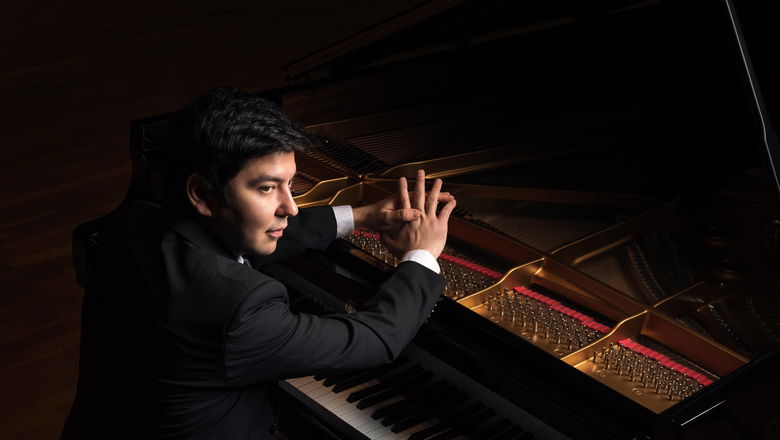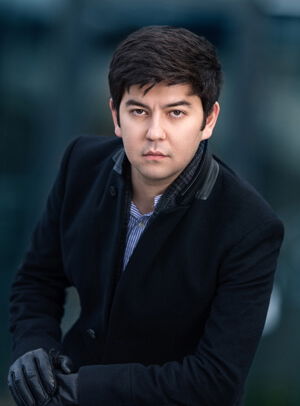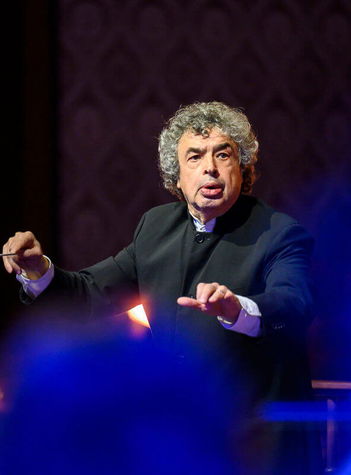Programme
Sergei Rachmaninoff
Rhapsody on a Theme of Paganini, Op. 43 (21')
— Intermission —
Dmitri Shostakovich
Symphony No. 11 in G minor, Op. 103, “The Year 1905” (55')
Secure your seat for the 2025/2026 season – presales are open.
Choose SubscriptionThe Russian programme opening Series A performed by artists of Uzbek and Russian origin will bear powerful testimony to the great musicality of two composers and the motivations that drove them. Behzod Abduraimov and Semyon Bychkov have a good reason for combining Rachmaninoff’s Rhapsody on a Theme of Paganini with Shostakovich’s Eleventh Symphony.
Subscription series A | Duration of the programme 1 hour 35 minutes
Sergei Rachmaninoff
Rhapsody on a Theme of Paganini, Op. 43 (21')
— Intermission —
Dmitri Shostakovich
Symphony No. 11 in G minor, Op. 103, “The Year 1905” (55')
Behzod Abduraimov piano
Semyon Bychkov conductor

The Czech Phil cameras make an audio-visual recording of concerts (it will be broadcast on www.symphony.live on Saturday, November 26, 2022).
The Paganini Rhapsody is very popular with pianists, and Behzod Abduraimov is no exception. He says: “The Rhapsody is one of my favourite compositions because the work contains an inexhaustible wealth of compositional and instrumental technique together with an enchanting musical programme. In it, you quickly find out not only whether you can play the piano, but also, above all, what kind of musician you are.” Shostakovich’s Symphony No. 11 was inspired by a workers’ protest in 1905 in Saint Petersburg that resulted in the event known as “Bloody Sunday”. However, the composer wrote the work after the revolution in Hungary in 1956, and the individual movements have both titles and an extra-musical programme.
Behzod Abduraimov piano

Described by The Times as the “master of all he surveys” and with The Washington Post noting to “keep your ear on this one”, Behzod’s captivating performances continue to receive international praise.
Recent seasons have seen Behzod work with leading orchestras worldwide, such as the Los Angeles Philharmonic, Boston Symphony, NHK Symphony and prestigious conductors including Vladimir Ashkenazy, Valery Gergiev, Manfred Honeck, Vasily Petrenko, James Gaffigan, Osmo Vänskä, Thomas Dausgaard and Vladimir Jurowski. He also toured China with the London Philharmonic Orchestra, and performed at the Festival Piano aux Jacobins in recital and in concert with the Orchestre National du Capitole de Toulouse under Tugan Sokhiev.
Continuing his collaboration with The Mariinsky Orchestra and Valery Gergiev, last season Behzod performed in their Prokofiev Piano Concerto cycle at concerts in Stockholm, Vienna and Dortmund. This was followed by a major tour of the US with them, which included his impressive concerto debut at Carnegie Hall. Shortly afterwards he gave his recital debut in the Weill Hall as part of the “Distinctive Debuts” series which resulted in an immediate reinvitation to the Stern Auditorium.
Behzod’s upcoming European highlights include concert debuts with the Münchner Philharmoniker, Gewandhausorchester Leipzig, Rotterdam Philharmonic Orchestra, Orchestre Philharmonique de Radio France and the Gothenburg Symphony. In recital Behzod is one of the featured artists for the Junge Wilde series at the Konzerthaus Dortmund for the next three years, and also gives recitals at Wigmore Hall, London; Salle Gaveau, Paris; MünchenMusik and AMG Konzerte Basel.
In the US, Behzod will make his debut with Seattle and Dallas Symphony orchestras and returns to the Los Angeles Philharmonic. In recital he will appear as part of the People’s Symphony Concerts, New York; Tuesday Evening Concert Series, Virginia; Shriver Hall Concert Series, Baltimore; Spivey Hall, Atlanta and the Washington Performing Arts Series.
An award-winning recording artist – his debut recital CD won both the Choc de Classica and the Diapason Découverte – Behzod released his first concerto disc in 2014 on Decca Classics which features Prokofiev’s Piano Concerto No. 3 and Tchaikovsky’s Concerto No. 1 with the Orchestra Sinfonica Nazionale della Rai under Juraj Valčuha.
Born in Tashkent in 1990 Behzod began to play the piano at the age of five. He was a pupil of Tamara Popovich at the Uspensky State Central Lyceum in Tashkent, and studied with Stanislav Ioudenitch at the International Center for Music at Park University, Kansas City, where he is now Artist in Residence.
Semyon Bychkov conductor

In addition to conducting at Prague’s Rudolfinum, Semyon Bychkov and the Czech Philharmonic in the 2023/2024 season, took the all Dvořák programmes to Korea and across Japan with three concerts at Tokyo’s famed Suntory Hall. In spring, an extensive European tour took the programmes to Spain, Austria, Germany, Belgium, and France and, at the end of year 2024, the Year of Czech Music culminated with three concerts at Carnegie Hall in New York.
Among the significant joint achievements of Semyon Bychkov and the Czech Philharmonic is the release of a 7-CD box set devoted to Tchaikovsky’s symphonic repertoire and a series of international residencies. In 2024, Semjon Byčkov with the Czech Philharmonic concentrated on recording Czech music – a CD was released with Bedřich Smetanaʼs My Homeland and Antonín Dvořákʼs last three symphonies and ouvertures.
Bychkovʼs repertoire spans four centuries. His highly anticipated performances are a unique combination of innate musicality and rigorous Russian pedagogy. In addition to guest engagements with the world’s major orchestras and opera houses, Bychkov holds honorary titles with the BBC Symphony Orchestra – with whom he appears annually at the BBC Proms – and the Royal Academy of Music, who awarded him an Honorary Doctorate in July 2022. Bychkov was named “Conductor of the Year” by the International Opera Awards in 2015 and, by Musical America in 2022.
Bychkov began recording in 1986 and released discs with the Berlin Philharmonic, Bavarian Radio, Royal Concertgebouw, Philharmonia Orchestra and London Philharmonic for Philips. Subsequently a series of benchmark recordings with WDR Symphony Orchestra Cologne featured Brahms, Mahler, Rachmaninov, Shostakovich, Strauss, Verdi, Glanert and Höller. Bychkov’s 1993 recording of Tchaikovsky’s Eugene Onegin with the Orchestre de Paris continues to win awards, most recently the Gramophone Collection 2021; Wagner’s Lohengrin was BBC Music Magazine’s Record of the Year (2010); and Schmidt’s Symphony No. 2 with the Vienna Philharmonic was BBC Music Magazine’s Record of the Month (2018).
Semyon Bychkov has one foot firmly in the culture of the East and the other in the West. Born in St Petersburg in 1952, he studied at the Leningrad Conservatory with the legendary Ilya Musin. Denied his prize of conducting the Leningrad Philharmonic, Bychkov emigrated to the United States in 1975 and, has lived in Europe since the mid-1980’s. In 1989, the same year he was named Music Director of the Orchestre de Paris, Bychkov returned to the former Soviet Union as the St Petersburg Philharmonic’s Principal Guest Conductor. He was appointed Chief Conductor of the WDR Symphony Orchestra (1997) and Chief Conductor of Dresden Semperoper (1998).
Sergei Rachmaninoff
Rhapsody on a Theme of Paganini, Op. 43
Sergei Rachmaninoff was one of the last musicians who was both a composer and a performer in the tradition of the great 19th century virtuosos. He wrote piano compositions primarily for his own use. His Rhapsody on a Theme of Paganini, Op. 43, is preceded by another set of variations also intended for piano and orchestra, Variations on a Theme of Corelli, Op. 42. In both cases Rachmaninoff chose a theme from the musical past, from pieces originally composed for violin. His Variations on Corelli are based on the theme of Corelli’s Sonata for Violin, Op. 5, No. 12 (which is, in fact, the traditional folk melody La Folia), while his Rhapsody elaborates the theme of Niccolò Paganini’s Caprice No. 24 for solo violin. Rachmaninoff wrote the Rhapsody in the summer of 1934 at his home near Lucerne. Its free form provided the composer with an open field for experimentation: 24 variations are structured roughly as a sonata, whose sections are defined by harmonic relationships and tempo contrasts. The introduction up to variation 10 can be understood as an allegro movement; variations 11 to 18 represent a slow movement (while variations 13–15 can be seen as an integrated scherzo within this slow movement), and the remaining variations 19–24 make a finale of the sonata. The centerpiece of this composition is variation 7, which features in place of Paganini’s theme the medieval plainchant Dies Irae, which Rachmaninoff quoted in his other pieces as well. The transformation of Paganini’s original theme into a melody that has endured for centuries and whose power still fascinates us today is a supreme example of Rachmaninoff’s compositional mastery.
The Rhapsody on a Theme of Paganini was first performed on 7 November 1934 in Baltimore with the Philadelphia Orchestra under the baton of Leopold Stokowski, while the soloist was of course Sergei Rachmaninoff. The composition soon gained popularity with audiences and pianists alike, and it also inspired the Russian choreographer Mikhail Fokine to turn it into a ballet. Fokine wrote to Rachmaninoff from Auckland, New Zealand, where he was touring, asking for his permission to create a choreography based on the legend of the “diabolical” roots of Paganini’s virtuosity. In the ballet, Paganini’s caprice theme and its variations represent the violinist himself, while the Dies Irae melody is the devil who controls his art. The ballet Paganini was successfully premiered by the Royal Ballet on 30 June 1939 at Covent Garden, London; other ballet performances followed later, adding to the work’s popularity.
Dmitri Shostakovich
Symphony No. 11 in G minor, Op. 103, “The Year 1905”
In September 1956 Dmitri Shostakovich celebrated his 50th birthday. He was considered the greatest symphonist of his time and was beginning to take stock. “I think that many things repeat themselves in Russian history. Of course the same event can’t repeat itself exactly, there must be differences, but many things are repeated nevertheless. People think and act similarly in many things… I wanted to show this recurrence in the Eleventh Symphony. I wrote it in 1957 and it deals with contemporary themes even though it’s called “1905”. It is about the people who have stopped believing because the cup of evil has run over. That is how the impressions of my childhood and my adult life come together.” Shostakovich himself was not witness of the bloody suppression of the 1905 St Petersburg uprising, but his family discussed this event all the time. He personally experienced the October Revolution of 1917, whose 40th anniversary had just been celebrated in 1957, and throughout his life he also felt its consequences: bullying and injustice on the one hand, and bombastic tributes and platitudes on the other. He was also constantly confronted with the regime that the 1917 Revolution had established, by which he was attacked and dragged under.
Symphony No. 11 in G minor, Op. 103, was written in 1957 during Shostakovich’s summer stay in Komarovo near what was then Leningrad. Two themes run through the entire work – the theme introduced by the string section at the beginning of the symphony and, in contrast, the ominous timpani strokes. These leitmotifs, which constantly undergo a transformation, symbolize the historical repetition of events mentioned by the composer over the course of four movements played without a pause. Other elements include quotations from 19th-century political songs – songs of the revolutionary year 1905, as well as from Shostakovich’s other compositions. The first movement, introduced by the two contrasting themes of strings and timpani, features a melody of the song “Slushay!” (Listen!) from 1864, followed by “Arrestant” (The Prisoner) from 1857. In the second movement Shostakovich has incorporated melodies from his Ten Choruses on Texts by Revolutionary Poets from 1951; they are gradually escalating into sharp marching rhythms. The uprising breaks out, is defeated, and a deathlike silence reigns outside the Winter Palace. The third movement is a symbolic remembrance of the fallen victims, featuring the well-known funeral march of the Russian revolutionaries “You Fell Victim to a Fateful Struggle” and quotes from other revolutionary songs such as “Baikal”, “'Boldly on We March, Comrades!” and “Welcome, Free Speech”. A new revolution sprouts out of the grief for the dead, and it spreads with the other songs included in the fourth movement. The coda, again with the motif of Palace Square, anticipates a new bloodshed and warns against it.
The symphony premiered on 30 October 1957 in Moscow under Natan Rakhlin. Understandably, it was met with mixed reactions. Party leaders ranked it among the exemplary works of Socialist Realism and honored the composer with the Lenin Prize, but in circles that had already begun to shake off the chains of demagoguery it was regarded as a libation and, as far as its artistic value was concerned, as illustrative film music. After another 50 years, many details of the composer’s complicated life, sandwiched between the millstones of constant party criticism and his own convictions as an artist and human being, are now known. The symphony is now seen in the spirit which Shostakovich himself suggested – as a manifestation of the strangely turning wheel of fate, which returns many moments of development to the starting point from which humanity sets out each time to find anew the justification for its existence.
The Russian programme opening Series A performed by artists of Uzbek and Russian origin will bear powerful testimony to the great musicality of two composers and the motivations that drove them. Behzod Abduraimov and Semyon Bychkov have a good reason for combining Rachmaninoff’s Rhapsody on a Theme of Paganini with Shostakovich’s Eleventh Symphony.